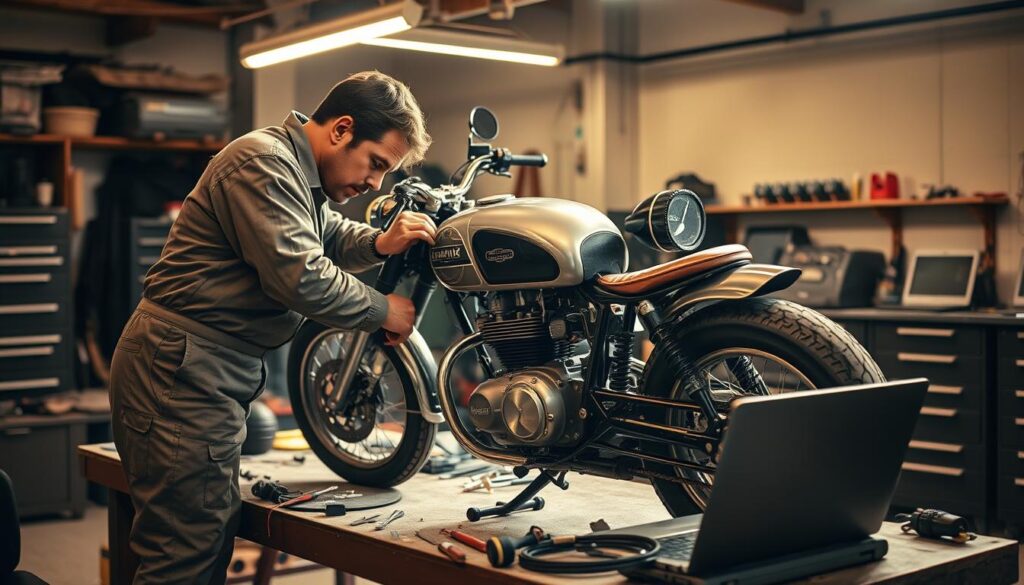As a motorcycle enthusiast, you love feeling free on the open road. But, it’s important to prepare for typical motorcycle issues. Finding places to stay that welcome bikers can give you not just a bed for the night. They also offer a safe spot for unexpected repairs. We’ll help you understand your bike better, know what to bring, and keep a good attitude when problems happen.
Why Motorcycle Breakdowns Happen
Motorcycle breakdowns can ruin your ride. Knowing why they occur is key to smooth travels. Often, they’re due to not enough motorcycle care or unexpected issues. Typical problems are flat tires, dead batteries, and engine troubles.
Flat tires can surprise you at the worst times. To avoid them, regularly check your tires and look for wear. Battery problems often come from not taking care of them. It’s good to check your battery’s connections and charge. Low oil can cause engine issues, leading to bigger problems.
Keeping up with your motorcycle’s maintenance lets you travel far without worries. Doing regular oil changes and checking brakes are key to avoid big repair bills. Being ready for any breakdowns makes the journey less stressful.
| Common Mechanical Issues | Preventative Maintenance |
|---|---|
| Flat Tires | Regularly check tire pressure and inspect for wear. |
| Battery Issues | Inspect battery connections and levels routinely. |
| Engine Problems | Monitor oil levels and change oil regularly. |
| Brake Failures | Check brake pads and fluid levels often. |
Common Types of Motorcycle Breakdowns
Riding a motorcycle and facing breakdowns can be annoying. Knowing common issues helps you get ready in advance. Three issues happen a lot: flat tires, battery problems, and running out of fuel.
Flat tires can surprise you, often caused by road debris or normal wear. Though many riders can change a tire, calling for help on busy roads is safer. This is because your safety is the most important thing.
Battery problems usually come from dead batteries, often by forgetting to turn off lights or using an old battery. Keeping up with maintenance can prevent these issues. A quick check can extend your battery’s life and lower breakdown risks.
Running out of fuel is also common. It occurs if your tank empties on a long trip. Planning your travel and watching your fuel gauge helps you avoid this issue. Always fill up before long trips to ensure a smooth journey.
Preparing for Common Motorcycle Breakdowns
Being prepared is key to avoiding motorcycle breakdowns. Doing regular maintenance can stop many issues before they start. This means checking your oil and keeping your tire pressure right. Doing these regularly keeps your bike going strong and performing well.
Having a motorcycle toolkit with you can help with fast fixes by the road. Your toolkit should have,
- Wrench sets
- Tire repair kits
- Battery jumper cables
These tools let you fix small problems quickly, so you’re not stuck for long. Besides tools, think about getting roadside assistance. It offers comfort and helps a lot with big problems. Being ready for breakdowns can turn a big problem into a small bump on your trip.
| Toolkit Item | Purpose |
|---|---|
| Wrench Set | Loosening or tightening bolts on various components. |
| Tire Repair Kit | Fixing punctures to keep you rolling. |
| Battery Jumper | Jump-starting a dead battery. |
Immediate Steps to Take During a Breakdown
When your motorcycle stops working, it can feel overwhelming. Yet, by acting wisely, you can keep safe and solve the problem faster. Move your motorcycle off the road first. Then, turn on your hazard lights to let others know you’re there.
Not being able to fix the problem on your own is okay sometimes. The key step here is to call for roadside help quickly. Make sure you tell them exactly where you are. This helps them get to you fast.
Don’t try to fix complex issues yourself next to a busy road. It’s safer to wait calmly for assistance. Each breakdown is a chance to learn something new. It makes you more ready for any future trips.
Essential Tools for On-the-Road Repairs
Having the right tools matters a lot when your bike breaks down. A good toolkit should have wrenches and screwdrivers. It should also include things for fixing tires like CO2 canisters and tire spoons. A portable air compressor or a pump works well for flat tires. This keeps you going on your adventure.
Knowing how to maintain your bike improves your use of these tools. Learn about the tools your bike specifically needs. This lets you fix small problems fast and avoid bigger ones later. Here are some key items you should carry:
- Complete set of wrenches and screwdrivers
- Tire repair kit, including CO2 canisters and tire spoons
- Portable air compressor or pump
- Multitool for various tasks
- Basic first aid kit for emergencies
- Flashlight or headlamp for visibility during repairs
Planning for Long-Distance Motorcycle Rides
When you plan to travel far on a motorcycle, good preparation is key. Look up routes that are not just quick but scenic and fun, too. Make sure to note gas stations, shops for bike repairs, and places to rest.
Telling friends or family about your travel plans makes the trip safer. They can keep an eye on you through your phone. This way, if something goes wrong, help isn’t far away.
Checking the weather and knowing what attractions are nearby is smart. Book your sleepovers before you start your ride. This way, you can just enjoy your trip without worry.

How to Handle Motorcycle Breakdowns in Remote Areas
A motorcycle breakdown in remote places can be tough. You can’t always get help right away, so being ready is crucial. Always have extra food, water, and a first-aid kit with you. Learning how to handle breakdowns can really up your safety game.
If you’re stuck out there, make sure your phone’s battery is full. It’s key for calling for help. If you end up stranded, stay with your bike because it’s easier for others to spot you. Use any lights you have to signal for help until it arrives. Taking these safety steps is super important during emergencies.
Getting ready is everything when you’re heading into remote spots. Knowing what to do if your motorcycle breaks down is super helpful. It gives you the tools to deal with tough situations.
Tips for Preventing Future Breakdowns
Keeping your bike in top shape requires regular care. By looking after your motorcycle, you lower the chance of surprises. Use good prevention tips for smoother rides.
Always check your tire pressure and keep it right. Low pressure can make your bike perform poorly and get flats. Change your oil regularly to keep your engine happy.
Don’t ignore your battery. Check it for corrosion and clean the connections. Replace a weak battery to avoid trouble on the road.
Choosing strong parts for your bike matters. They lead to better performance and less trouble. Pick brands with a strong performance record.
Make a maintenance checklist to stay on track. It helps you remember what to do to keep your bike running well.
Troubleshooting Common Motorcycle Issues
Learning to troubleshoot your motorcycle can quickly solve many engine problems. You may notice issues like stalling or power loss. First, check the fuel flow to the engine. Make sure there are no blockages in the fuel lines.
Then, look into electrical issues, which can stem from bad wiring or a weak battery. Knowing your bike’s electrical system helps you find problems faster. Ensure connections are tight, wires are intact, and the battery is charged. This knowledge helps you fix many common issues.
Getting to know these troubleshooting steps makes you more confident in handling emergencies. The better you understand your motorcycle’s inner workings, the more prepared you’ll be if it breaks down.

Safety Precautions During Breakdowns
Keep safety first if your motorcycle breaks down. Find a safe spot to pull over, making sure it’s away from heavy traffic. Make sure your bike is on solid ground. Turn on your hazard lights to alert other drivers. And if you can, wear something bright to stand out more.
Don’t try to fix your bike in risky places. If you’re on a busy street, keep a safe distance from traffic and wait for help. Staying calm helps you think clearly and solve the problem better. For more safety tips, especially on dealing with brakes, check out brake maintenance techniques.
Conclusion: Mastering Common Motorcycle Breakdowns
Mastering motorcycle breakdowns takes more than just knowing how things work. It also requires good preparation and a big focus on staying safe on the road. Learning about common problems and how to fix them makes your rides better. Having the right tools and keeping your bike well-maintained means you’re always ready to hit the road and enjoy every trip.
See breakdowns as chances to learn, not just problems. This way of thinking helps you feel confident to face any issues on your trips. Every breakdown is a lesson, helping you make smarter choices later.
Using these tips during your bike journeys prepares you for any trouble and adds fun to your rides. Being smart about your bike’s needs lets you handle the road better. You turn challenges into easy steps as you explore new paths.




